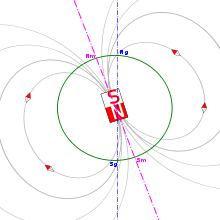Geomagnetic pole

The geomagnetic poles are antipodal points where the axis of a best-fitting dipole intersects the Earth's surface. This dipole is equivalent to a powerful bar magnet at the center of the Earth, and it is this theoretical dipole that comes closer than any other to accounting for the magnetic field observed at the Earth's surface. In contrast, the actual Earth's magnetic poles are not antipodal—that is, they do not lie on a line passing through the center of the Earth.
Owing to motion of fluid in the Earth's outer core, the actual magnetic poles are constantly moving. However, over thousands of years their direction averages to the Earth's rotation axis. On the order of once every half a million years, the poles reverse (north changes place with south).
Definition
As a first-order approximation, the Earth's magnetic field can be modelled as a simple dipole (like a bar magnet), tilted about 9.6° with respect to the Earth's rotation axis (which defines the Geographic North and Geographic South Poles) and centered at the Earth's center.[1] The North and South Geomagnetic Poles are the antipodal points where the axis of this theoretical dipole intersects the Earth's surface. If the Earth's magnetic field were a perfect dipole then the field lines would be vertical at the Geomagnetic Poles, and they would coincide with the North and South magnetic poles. However, the approximation is imperfect, and so the Magnetic and Geomagnetic Poles lie some distance apart.[2]
Location
Like the North Magnetic Pole, the North Geomagnetic Pole attracts the north pole of a bar magnet and so is in a physical sense actually a magnetic south pole. It is the center of the 'open' magnetic field lines which connect to the interplanetary magnetic field and provide a direct route for the solar wind to reach the ionosphere. As of 2015 it was located at approximately 80°22′N 72°37′W / 80.37°N 72.62°W, on Ellesmere Island, Nunavut, Canada.[1]
The locations of geomagnetic poles are predicted by the International Geomagnetic Reference Field, a statistical fit to measurements of the Earth's field by satellites and in geomagnetic observatories.[3] If the Earth's field were exactly dipolar, the north pole of a magnetic compass needle would point directly at the North Geomagnetic Pole. In practice it does not because the geomagnetic field that originates in the core has a more complex non-dipolar part, and magnetic anomalies in the Earth's crust also contribute to the local field.[1]
Movement
The geomagnetic poles move over time because the geomagnetic field is produced by motion of the molten iron alloys in the Earth's outer core (see geodynamo). Over the past 150 years the poles have moved westward at a rate of 0.05° to 0.1° per year, with little net north or south motion.[2]
Over several thousand years, the average location of the geomagnetic poles coincides with the geographical poles. Paleomagnetists have long relied on the Geocentric axial dipole (GAD) hypothesis, which states that, aside from during geomagnetic reversals, the time-averaged position of the geomagnetic poles has always coincided with the geographic poles. There is considerable paleomagnetic evidence supporting this hypothesis.[4]
Geomagnetic reversal
Over the life of the Earth, the orientation of Earth's magnetic field has reversed many times, with geomagnetic north becoming geomagnetic south and vice versa – an event known as a geomagnetic reversal. Evidence of geomagnetic reversals can be seen at mid-ocean ridges where tectonic plates move apart. As magma seeps out of the mantle and solidifies to become new ocean floor, the magnetic minerals in it are magnetized in the direction of the magnetic field. Thus, starting at the most recently formed ocean floor, one can read out the direction of the magnetic field in previous times as one moves further away to older ocean floor.
See also
Notes
- 1 2 3 "Geomagnetism Frequently Asked Questions". National Geophysical Data Center. Retrieved 1 June 2016.
- 1 2 Merrill, McElhinny & McFadden 1996, Chapter 2
- ↑ IAGA Division V Working Group V-MOD. "International Geomagnetic Reference Field". Retrieved September 2011. Check date values in:
|access-date=(help) - ↑ Merrill, McElhinny & McFadden 1996, Chapter 6
References
- McElhinny, Michael W.; McFadden, Phillip L. (2000). Paleomagnetism: Continents and Oceans. Academic Press. ISBN 0-12-483355-1.
- Merrill, Ronald T. (2010). Our Magnetic Earth: The Science of Geomagnetism. University of Chicago Press. ISBN 0-226-52050-1.
- Merrill, Ronald T.; McElhinny, Michael W.; McFadden, Phillip L. (1996). The magnetic field of the earth: Paleomagnetism, the core, and the deep mantle. Academic Press. ISBN 978-0-12-491246-5.